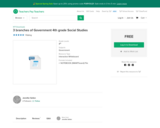
Jeopardy game used for reviewing 3 branches of government.
- Subject:
- Social Science
- Material Type:
- Activity/Lab
- Author:
- Jennifer Sellen
- See All Resources
- Date Added:
- 04/07/2021

Jeopardy game used for reviewing 3 branches of government.

lesson plan for a student research project on animals

Students are figuring out what economics is. Students will look at Michigan products and how geography can effect economic activities.

3rd Grade Eureka Math Resources
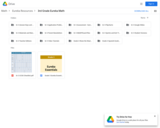
3rd Grade Eureka Math Resources
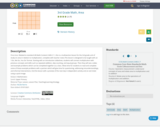
Overview: Related to standard AR.Math.Content.3.MD.C.7., this is a multisection lesson for the 3rd grade unit of study on area in relation to multiplication, complete with teacher notes.This lesson is designed to be taught with an 'I Do, We Do, You Do' format. Starting with an introduction slideshow, students will connect multiplication with previous concepts and skills such as repeated addition, skip counting, and equal groups. Then they will see a video and example problems which can be completed together as a class. Allow time for students to read and complete some of these example problems with a partner which will give time for questioning, addressing misunderstandings, and informal interventions. End the lesson with a preview of the next day's independent activity and an exit ticket using a quick image.

This Roadmap is a full year plan that covers the geography, economics, government and history of Michigan.
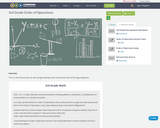
This is a short lesson plan for discussing/reviewing order of operations with technology integration.
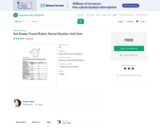
Students chose one of the five regions of the United States. They make a travel brochure including information about the region. Including natural/man-made landmarks, activities to do depending on landforms in the region, climate, map, and natural resources found in the area. I made a rubric with...
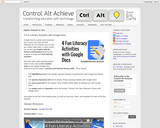
Google Docs is a great word processor, but is much more than just that. Although we can certainly use it to type up a report, take notes, or write a story, we can also get creative with the features and functions built into the program to make some fun learning activities.
Recently I did a video training webinar where I took a look at four creative ways to use regular Google Docs features in new fun ways to practice and develop literacy skills. These include:
The highlighting tool for the activity "Improve Reading Comprehension with Google Docs Black Out"
The special characters tool for the activity "Emoji Learning Activities with Google Docs"
The word count tool for the activity "Have Students Write Better by Writing Less with Google Docs"
The header tool and hyperlink tool for the activity "Choose Your Own Adventure Stories with Google Docs"
See below for the full 1-hour training video, as well as resources, ideas, and templates for each of the four activities.
Session Resources
Session Agenda - Google Docs link
Training Video (1 hour)
1) Improve Reading Comprehension with Docs Black Out
Description: In this activity students use the highlighter tool to black out any text that is not critical, leaving behind just the main ideas.
Resources: For full details and resources for doing this activity, see my original blog post "Improve Reading Comprehension with Google Docs Black Out"
Below is the portion of the training video that covers this specific activity:
2) Emoji Learning Activities
Description: In this activity students use special characters to insert emojis to summarize stories, write creatively, and explore character emotions.
Resources: For full details and resources for doing this activity, see my original blog post "5 Emoji Learning Activities with Google Docs"
Below is the portion of the training video that covers this specific activity:
3) Have Students Write Better by Writing Less
Description: In this activity students use the word count tool to write within a character limit or word limit.
Resources: For full details and resources for doing this activity, see my original blog post "Have Students Write Better by Writing Less with Google Docs"
Below is the portion of the training video that covers this specific activity:
4) Choose Your Own Adventure Stories
Description: In this activity students use headings and hyperlinks to create interactive stories in Google Docs.
Resources: For full details and resources for doing this activity, see my original blog post "Choose Your Own Adventure Stories with Google Docs"
Below is the portion of the training video that covers this specific activity:
Post by Eric Curts. Bring me to your school, organization, or conference with over 50 PD sessions to choose from. Connect with me on Twitter at twitter.com/ericcurts and on Google+ at plus.google.com/+EricCurts1

This is a task from the Illustrative Mathematics website that is one part of a complete illustration of the standard to which it is aligned. Each task has at least one solution and some commentary that addresses important asects of the task and its potential use. Here are the first few lines of the commentary for this task: Which of the polygons are right triangles? Choose a measuring tool to help you determine this. These are right trianglesThese are not right triangles F...
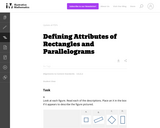
This is a task from the Illustrative Mathematics website that is one part of a complete illustration of the standard to which it is aligned. Each task has at least one solution and some commentary that addresses important asects of the task and its potential use. Here are the first few lines of the commentary for this task: Look at each figure. Read each of the descriptions. Place an X in the box if it appears to describe the figure pictured. A. B. C. D. 4 vertices Four si...
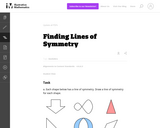
This is a task from the Illustrative Mathematics website that is one part of a complete illustration of the standard to which it is aligned. Each task has at least one solution and some commentary that addresses important asects of the task and its potential use. Here are the first few lines of the commentary for this task: Each shape below has a line of symmetry. Draw a line of symmetry for each shape. Not every shape has an line of symmetry. Which of the four shapes belo...
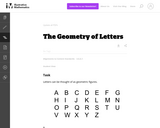
This is a task from the Illustrative Mathematics website that is one part of a complete illustration of the standard to which it is aligned. Each task has at least one solution and some commentary that addresses important asects of the task and its potential use. Here are the first few lines of the commentary for this task: Letters can be thought of as geometric figures. How many line segments are needed to make the letter A? How many angles are there? Are they acute, obtu...
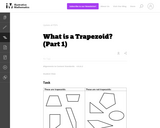
This is a task from the Illustrative Mathematics website that is one part of a complete illustration of the standard to which it is aligned. Each task has at least one solution and some commentary that addresses important asects of the task and its potential use. Here are the first few lines of the commentary for this task: Say what a trapezoid is in your own words. Compare your definition with a partner. Is this parallelogram a trapezoid according to your definition? Expl...

This is a task from the Illustrative Mathematics website that is one part of a complete illustration of the standard to which it is aligned. Each task has at least one solution and some commentary that addresses important asects of the task and its potential use. Here are the first few lines of the commentary for this task: Draw at least two examples and two non-examples of each of the quadrilaterals defined below. Parallelogram: A quadrilateral with 2 pairs of parallel si...
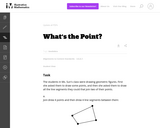
This is a task from the Illustrative Mathematics website that is one part of a complete illustration of the standard to which it is aligned. Each task has at least one solution and some commentary that addresses important asects of the task and its potential use. Here are the first few lines of the commentary for this task: The students in Ms. Sun's class were drawing geometric figures. First she asked them to draw some points, and then she asked them to draw all the line ...
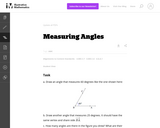
This is a task from the Illustrative Mathematics website that is one part of a complete illustration of the standard to which it is aligned. Each task has at least one solution and some commentary that addresses important asects of the task and its potential use. Here are the first few lines of the commentary for this task: Draw an angle that measures 60 degrees like the one shown here: Draw another angle that measures 25 degrees. It should have the same vertex and share s...

This is a task from the Illustrative Mathematics website that is one part of a complete illustration of the standard to which it is aligned. Each task has at least one solution and some commentary that addresses important asects of the task and its potential use. Here are the first few lines of the commentary for this task: Margie bought 3 apples that cost 50 cents each. She paid with a five-dollar bill. How much change did Margie receive?...

This is a task from the Illustrative Mathematics website that is one part of a complete illustration of the standard to which it is aligned. Each task has at least one solution and some commentary that addresses important asects of the task and its potential use. Here are the first few lines of the commentary for this task: Mr. Liu asked the students in his fourth grade class to measure their heights. Here are some of the heights they recorded: StudentHeight Sarah 50 inche...